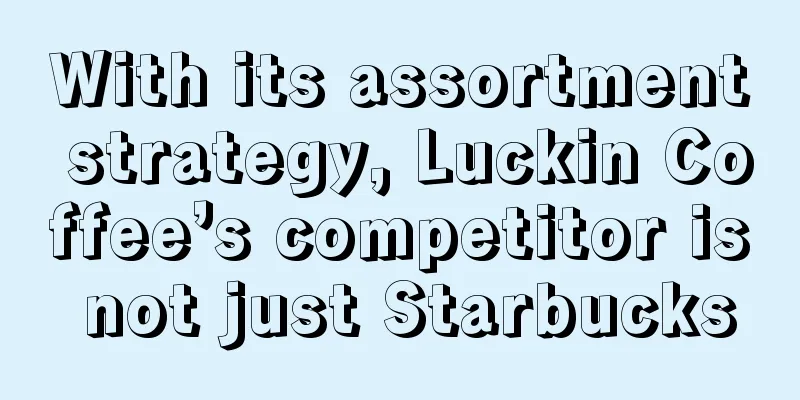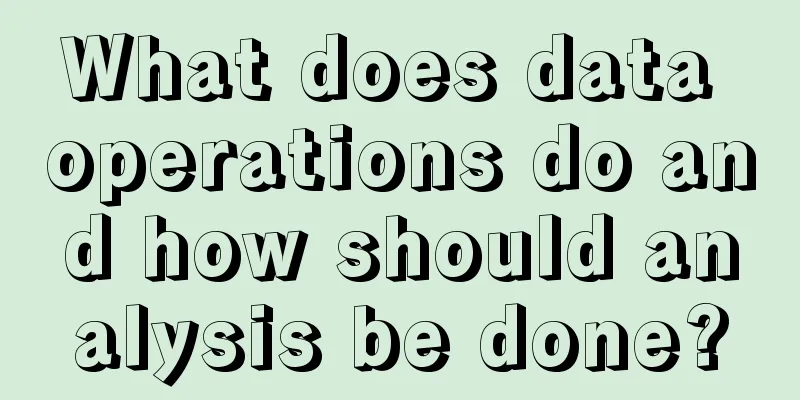With its assortment strategy, Luckin Coffee’s competitor is not just Starbucks

I saw Liu Yifei’s Luckin Coffee advertisement in the elevator, promoting a new product called Qingqing Jasmine. The slogan was: coffee in the morning, tea in the afternoon. Luckin is a coffee brand, why is it making tea? In the minds of users, this is not a problem. Category boundaries don’t matter. I have bought many new products similar to milk tea from Luckin Coffee before. Some people say that Luckin's Qingqing Jasmine is imitating Boya Juexian, but after drinking it, I didn't feel that they were very similar. The former has a stronger milk flavor, while the latter has a more obvious tea flavor. Of course, I am not a standard. I went to Xiaohongshu to read the feedback and saw that they were all making comparisons, but there was no clear conclusion. Taste is not the most important thing. This time, Luckin Coffee has separated out the "tea" category, which is different in nature and represents the expansion of its business direction: From freshly brewed coffee to freshly brewed tea drinks (coffee + milk tea), we officially declare war on the tea queens. From the perspective of brand growth, Luckin Coffee is reclassifying the market and finding its own market, which is also an opportunity to maximize profits. In other words, it is: coffee beverageization. Luckin Coffee has turned coffee into a beverage, which is a classification and a strategic thinking. How you classify determines how you view the market and products, and how you do business. So, my core point is: classification determines everything. This article takes Luckin Coffee as an example to explain how classification determines everything and what reference value it has for brand growth. In the early days of Luckin Coffee, it targeted white-collar workers in first-tier cities. The store is located in an office building, the spokespersons are Tang Wei and Zhang Zhen, and the promotion is to offer a second cup at half price... all of these are aimed at office workers. But this market is not big, and our per capita coffee consumption is much less than that of Japan, the United States, and South Korea. The conclusion is that Luckin's model will definitely not work if it focuses on classic categories, such as Americano, mocha, latte, cappuccino, not to mention SOE. You will find that this is the case with many things. The more specialized and niche the business is, the lower the ceiling will be, and there will even be an anti-scale effect. Unless you do business with a high unit price, you will not make any money. The solution is to expand the market and make it bigger and more widespread. How can we be more general? How should we think about this problem? Logically, we should look up one category. Luckin Coffee was initially in the freshly ground coffee category, which is in the same dimension as instant coffee and ready-to-drink coffee. The next category up is freshly brewed beverages, and in this category, tea drinks have a larger market share. It is easy to understand that when it comes to the tea beverage market, the base becomes larger and the size of the entire audience increases exponentially. Let’s put Luckin Coffee aside for now and look at some other cases. Case 1: Meituan As a company that started out as a group-buying company, why did it want to do ride-hailing and bike-sharing? It seems to have nothing to do with the core business. If you have this question, it means you don’t understand the boundaries of Meituan. The answer lies in how Meituan classifies the market. It is easy to describe it clearly using Wang Huiwen's words. Meituan divides its business into online and offline according to "supply and fulfillment", and then the offline business is divided into SKU and Location as the center. With these two cuts, Meituan’s business boundaries are clearly defined. Now it is clear that doing taxi-hailing, bicycle-hailing, and food delivery is very reasonable and is within the framework drawn by others. Case 2: Toutiao Zhang Yiming positioned Toutiao as a "content platform" where content of all forms and themes can appear and be distributed to users using algorithms. NetEase News considers itself a news client that focuses on news and pays more attention to content sources, quality and timeliness. Toutiao’s business classification is: content or non-content, which crushes NetEase’s news or non-news. Because content is the upper level of news, the former completely covers the latter. Different categories mean that the entire product model is different, and even the organizational division of labor is very different. In the past, news portals relied on editors to produce content, which was either completely original or compiled and edited. In short, all content would pass through their hands. But Toutiao is a self-media platform, and the scale of content supply is completely different. If we measure labor productivity based on Toutiao’s model, the news portal’s productivity would be very low, which directly led to layoffs that year. Case 3: Super Bowl The light meal category has not been popular in the past few years. The reason is simple. For brands that make light meals, nutritional ratio and calorie intake are important criteria for product development. But the problem is that they are not tasty and do not give a good sense of fullness. Products like salads are not suitable for Chinese people's eating habits. Although they are healthy, it is difficult to stick to eating them, so naturally there is no repurchase. Super Bowl does not define itself as a light meal, but rather meets the needs of young people who want to lose weight and be healthy, but still want to eat. It doesn’t have to be a light meal, as long as it fills you up and is healthy. In essence, it is bringing the niche category of light meals down to the mass market. Not only has the pattern been expanded, but the market size has also expanded. Business that could not be done in the light food category before may be done better this time. Case 4: Get In its early days, Getui was called Logical Thinking and was classified in the knowledge payment track. The timing of entry was very good and the field to be explored was relatively blank. However, it is unclear what category paid knowledge belongs to, who it is on the same level with, and what is above and below it. Therefore, a new classification perspective is needed to find its own space in the original education industry. This was described very clearly in the prospectus released earlier. In the traditional education industry, they used their own logic to squeeze out a new market. And the market is huge, and they are the only one. This is how they describe their target group:
How should the educational needs of the three groups facing these challenges be met? This is a very easy-to-understand market and population division, which firmly anchors the industry position obtained. After the case study, I basically understood what classification is all about. The significance of classification is not only in terms of strategic direction or Luckin’s product category extension, but also in terms of the company’s overall strategic decision-making and communication and collaboration: 1. Identify patterns: By grouping similar things together, it becomes easier to identify patterns and trends. The human brain is wired to seek cognitive economy, that is, to process information with the least amount of cognitive resources. Categorization allows us to simplify complexity by grouping things into known categories, thereby reducing cognitive load. 2. Simplify decision-making: Classification can help us make decisions quickly. Because we can predict the behavior of unknown things based on known category features. Classification is part of information processing, helping people simplify the cognitive process by encoding, storing and retrieving information. Simplifying information reprocessing improves decision-making efficiency and reduces decision-making difficulty and risk. 3. Promote communication: Classification provides a common language. It is what we often call a discourse system, which ensures that there are no information barriers and improves communication efficiency. Don't underestimate these things, they are quite important. I have a client who, after in-depth understanding, felt that there was a serious information gap within their team, so they called all the management together to discuss the company's direction and goals. As a result, the boss was dumbfounded. Every executive said something different, and the key point was that the way of expression and wording were different. On the surface, everyone is not in the same discourse system. In essence, there are big problems with the company's mission, vision, values, strategic direction, business collaboration, and even personal feelings. This will lead to everyone working in different directions, and the harder you work, the worse it will be. But this situation is not uncommon. I have seen too many executive review meetings where every VP said that his or her goals had been achieved, but in the end it was discovered that the company's goals had not been achieved, 1+1+1+1<1. Classification can help companies find their business boundaries. Only with boundaries can they know how to explore and even make good internal decisions. Classification can also help investors and users better understand the company, so that they can support them and buy their services. When we push the car together, we will push it in one direction. How to implement the classification strategy? There is a key point: Insight first, then classification. Without sufficient understanding of the industry, the market, the competitors, and yourself, it is just a theory. Once you start to act, you will find that it has no guiding significance. Although there are many successful cases mentioned above, it is hard to say whether they came up with the classification first or summarized it after achieving results. For example, Getai was able to target the knowledge payment track in the early stage, which was a very strategic vision. It was impossible for it to draw the "lifelong education" category at that time. This is the same for any company, brand, or even individual that is in a period of confusion. When we summarize successful experiences, we always have preset results first and then summarize them. We often come to a comfortable and self-consistent result. Success stories are the easiest to tell. But in reality, you must explore in the dark first, and you cannot avoid the pitfalls and pay the tuition. When you are just exploring, the concept of classification can help you preset the market structure and assist in thinking about the future direction. Explore and get feedback, but don't rush to make decisions. After going through this dark stage, you will have your own understanding of what you have done. At this time, referring to successful experiences may provide some inspiration. That’s all. Classification is strategic thinking that determines all strategies and execution. This concept is based on people's understanding and insight into things. Make good insights and then classify. |
<<: Please note that this is the first Olympics where advertising is sold programmatically.
Recommend
What does Amazon's Pan-European program mean and what does it do?
Now many friends will try to open a store on Amazo...
How is the starday platform? What are its advantages?
As the world's third largest economy, Japan ha...
Leftovers blind box: a new solution for catering under the pursuit of high productivity and sustainability?
Recently, blind boxes of leftovers have been hotly...
100 Keyword Predictions for 2023 | Beauty (51-60): Adaptogens, Anti-hair loss and Skin circulation
WPP's brand Wunderman Intelligence released it...
What should I do if the traffic of my new Shopee store is 0? How can I increase the traffic?
For Shopee merchants, store traffic is very import...
3,300 stores opened in 10 years, how can the fresh food industry do a good job in private domain? An article dismantles Qiandama’s private domain system
At present, Qiandama has set up stores in more tha...
Are young people addicted to live broadcasts of opening clams? The tricks of buying pearls are complicated!
Recently, live broadcasts of pearls opening have b...
Is it necessary to pay the deposit of Shopee? What will happen if I don't pay it?
In fact, more and more people are now aware that c...
Which cross-border e-commerce platforms allow individuals to open stores? Cross-border e-commerce platform recommendations
On cross-border e-commerce platforms, many stores ...
What is Shopee? What are the conditions and fees for joining Shopee?
Friends who do cross-border e-commerce should all ...
How should a novice Amazon seller operate? Is it easy to operate an Amazon store?
For novice sellers, how to successfully operate a ...
Luckin Coffee: The road to innovation from selecting hit products to building an independent brand of a major product
Over the past few years, Luckin Coffee has undergo...
Yuanqi Forest: A year of paying tuition to giants
Yuanqi Forest, a beverage brand that once rose rap...
More than 7,000 words of hardcore sharing, 13 suggestions for operating WeChat public accounts in 2024
At present, the overall operation data of public a...
Xiaohongshu local store traffic surged 200%
It has become a common phenomenon for offline stor...









